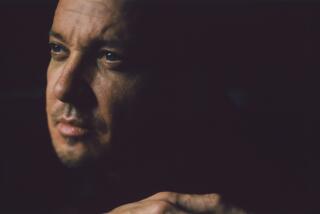A new ‘Woman’
One of the more intriguing “lost” musicals of Broadway’s golden age has been reborn 57 years later as a major new work in the repertory of Dance Theatre of Harlem.
The 1946 “St. Louis Woman,” with a majestic Harold Arlen-Johnny Mercer score, was recorded in aborted form and adapted into an unsuccessful opera. But after 113 performances, it joined the ranks of short-lived shows with strong music and a weak book whose original orchestrations were scattered to the winds.
Now, though, Della Green, the eponymous “woman” -- a role once envisioned for Lena Horne -- has become a sleek ‘40s vamp in toe shoes. The vibrant, celebratory (and at times shady) assemblage of characters who hang out, drink and gamble in Biglow Brown’s bar near the St. Louis racetrack is embodied by DTH’s dancers, who in addition to their prowess in George Balanchine works and the classics have always displayed a flair for imbuing dance with drama and vivid characterizations. The plot concerns shifting romantic entanglements, and their attendant betrayal and jealousy, and also features themes of fate and chance, luck and curses.
The choreography for the hourlong “St. Louis Woman: A Blues Ballet,” to be presented at the Dorothy Chandler Pavilion next Saturday and Sunday, is by Michael Smuin, whose career has encompassed Broadway and film work as well as ballet, and the $1-million production boasts a top-of-the-line Broadway design team: The sets are by Tony Walton, the costumes by Willa Kim and the lighting by the team of Jules Fisher and Peggy Eisenhower.
Three singers perform some of the show’s numbers -- among them “Come Rain or Come Shine” and “Any Place I Hang My Hat Is Home” -- while others are heard within the score that Joseph E. Fields, DTH’s music director, arranged and orchestrated from various Arlen sources, including an orchestral suite the composer excerpted from “Free and Easy,” the 1959 operatic version of the show. Fields also composed additional music as the score required, which he describes as “new material but derived from the feel of Arlen’s harmonies.”
It was an acquaintance who is a board member of the Johnny Mercer Foundation who suggested to Arthur Mitchell, the indefatigable founder/artistic director of DTH, that “St. Louis Woman” had potential as a ballet. Mitchell quickly took the idea and ran with it.
Speaking recently in his Harlem office, he noted that ever since performing in a later Arlen show, the 1954 “House of Flowers,” “I’ve always loved Arlen’s music. I thought it could make a wonderful ballet, because even though the plot is not that heavy -- there’s not that much there -- the music is beautiful, and it’s by two of America’s great songwriters. And it would be a wonderful vehicle for the company.”
The project also fit in well with Mitchell’s aspirations for his troupe. “Since the inception of Dance Theatre,” he explained, “I’ve said one of my goals is popularization of the fine arts. There’s a very thin line between that and just entertainment. Popularization of the fine arts doesn’t mean the classical technique is any less refined but that the performance also should be palatable for someone who wouldn’t normally go to a ballet. And now after seeing it, they will want to go to the ballet.”
Mitchell approached Smuin to choreograph “St. Louis Woman” for a number of reasons, he said. “Michael and I have worked together for many years, and the company has done a lot of his works. We both worked as choreographers on the film ‘Cotton Club.’ He is still basically a ballet dancer, but he also knows many different styles.”
Smuin, a former artistic director of San Francisco Ballet who began his career as a dancer with American Ballet Theatre, has shown a particular affinity for period Broadway musicals, having contributed the choreography to the long-running “Sophisticated Ladies” (1980) and an acclaimed 1987 revival of “Anything Goes.”
During a phone interview from San Francisco, he described this project as “a hybrid. There are so many different dance vocabularies that are used in it. It’s more than just a ballet.”
Unlike some dances that are produced in a rushed, condensed space of time, “St. Louis Woman” evolved gradually. Nearly two years passed between the early discussions involving Mitchell and Smuin and the premiere. “We had the luxury of time,” the choreographer said. “Whenever I had time to leave San Francisco and our calendars worked out, I would come to New York -- three weeks here, two weeks there, over the period of a year.”
Smuin also created a pivotal character identified in the program as Death -- a slinky, stealthy figure of fate who insinuates himself into the other characters’ actions.
Mitchell said the character would more accurately be called the Conjure Man, a figure who appeared in a song from the original show. Smuin describes him as “a wheeler-dealer who collected bets. The role helped glue parts of the story together.”
The choreographer also moved the original 1890s setting of the musical up to the 1940s, when it was composed. “I felt the costumes of that earlier period were so cumbersome. I wanted people to see the bodies, and for me it seemed to work a lot better set in the period when the musical was written,” he said. An extended cakewalk number remains, as a competitive event for couples at the bar, even though that dance belongs to the earlier era. But, Mitchell said, “most of it is seen through the prism of ballet.”
“I told the dancers to read the Broadway script,” he said, “and then I had everybody write one-page descriptions of who they were in the ballet -- where they came from, what their relationship was to the main characters, why they frequented the bar, did they bet on the races. When everybody pulled out their sheet and each person read who they were, some of them were amazing. After that, there was a much more clear focus about the characters.”
Donald Williams -- DTH’s ever-youthful senior principal dancer, who portrays the commanding, dangerous Biglow Brown -- observes that Smuin’s approach “made you take your character a bit deeper: deciding where you’re coming from, what your character’s job is. It made everyone really delve into their characters. Biglow is a gangster/bar owner. He’s streetwise, a ladies’ man, not someone to mess with.
“I’ve danced in four other Smuin ballets, and I worked with him on a swing number in ‘Cotton Club’ that he and Arthur Mitchell choreographed. For this ballet, he was driven by the characters and the story. His pas de deux work in this ballet is wonderful and challenging,” said Williams, who performs extended, contrasting duets -- one a sensual tango-flavored seduction, the other an angry dance of rejection -- with different ballerinas.
Another major contribution to the look and style of “St. Louis Woman” are Walton’s colorful, witty sets. The veteran designer had a long-standing interest in the musical and at one point owned the rights to it. (He surrendered them when a record company was planning an all-star recording that would include Sammy Davis Jr. and Lena Horne -- a project that did not materialize.)
“Arthur was very clear that while this piece would have an American jazz-blues feeling, he didn’t want to lose the classical ballet roots of the company,” Walton said this month. “I was trying to tap into that, partly by drawing on Matisse’s book of paper cutouts, which is titled ‘Jazz,’ and also by looking at Romare Bearden, the great Harlem artist who was also quite a musician. I hope it has the look of a Diaghilev ballet, and Willa Kim has also followed through on that.
“One particular challenge was to try and incorporate the singers. I created a little bandstand in the upstage-right back wall for them. What we hoped to do, and might still do, is to have a small jazz band up there, some musicians along with singers. That’s something that you see a lot in Bearden’s paintings.”
The further development that Walton alludes to is on the mind of all the collaborators. Since “St. Louis Woman” premiered in July at New York’s Lincoln Center Festival, there has been interest on the part of some producers in expanding it into a full-evening work that could run on Broadway or in London’s West End. This would involve adding another half-hour of material, creating more of a libretto.
“We’re in an exploratory process now,” Walton said.
For the moment, “St. Louis Woman” is in demand at DTH’s touring venues, which will include 14 more U.S. cities by mid-June, and Mitchell likes to pair it with a Balanchine ballet to set up a contrast. (“Serenade,” the seminal 1934 work that was the Russian-born choreographer’s first creation for American dancers, will open the program at the Chandler Pavilion.)
“This was such an ambitious project. A lot of people thought we would never make it happen,” Mitchell said. “When the curtain opened at the first dress rehearsal, we were all floored. Everything came together at the right time.”
*
Dance Theatre of Harlem
When: Saturday, 7:30 p.m.; Sunday, 2 and 7:30 p.m.
Where: Dorothy Chandler Pavilion, 135 N. Grand Ave., Los Angeles
Price: $25-$75
Contact: (213) 972-0711
More to Read
The biggest entertainment stories
Get our big stories about Hollywood, film, television, music, arts, culture and more right in your inbox as soon as they publish.
You may occasionally receive promotional content from the Los Angeles Times.






